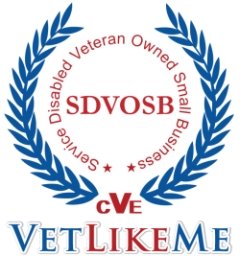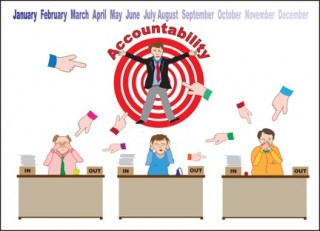

Deputy VA Secretary Cites Leadership Failures
(6 August, Dan Elliot, New York, NY)
Failed leadership is one reason some veterans hospitals are falling short as others excel, Deputy Veterans Affairs Secretary Sloan Gibson said.
Gibson told a convention of wounded combat veterans in Denver on Tuesday that more VA employees will be disciplined as the agency tries to root out the causes of a scandal over long waits for health care and falsified data.
Gibson planned to visit the Denver veterans hospital on Wednesday before leaving Colorado to tour facilities in Seattle and Portland, Oregon.
The VA has been shaken by reports that ve1terans died while waiting for treatment and allegations that workers falsified records to cover up the delays, in some cases so the workers could collect bonuses.
The agency announced last week that it planned to fire two supervisors and discipline four other employees in Colorado and Wyoming accused of falsifying health care data.
“These were the first in what I expect will be a long series of announcements of personnel actions,” Gibson told the Military Order of the Purple Heart, an organization of veterans who received the medal for combat wounds. Gibson said when he visited the troubled Phoenix VA hospital, some employees choked back tears describing the obstacles they encountered in trying to care for veterans.
“What I saw was leadership failure, mismanagement and chronic underinvestment,” he said.
Leadership was the difference between the Phoenix facility and the well run veterans hospital in San Antonio, he said.
“Everywhere I turned I saw excellence” at the San Antonio facility, he said. “But for leadership, Phoenix could have looked like that.”
Gibson praised Congress for approving $16.3 billion to help shorten the waits, including $10 billion for veterans to get care from private doctors, called purchased care.
Veterans who live in remote areas or need specialized care should be able to see outside doctors, Gibson said, and they can help in emergencies, such as the current VA crisis. But he cautioned that outside care has limits.
“Purchased care is not a replacement for a strong and vital veterans health care system,” he said.
courtesy Wayne Gatewood/VA Public Affairs
Veterans’ Bill Tested Sanders’ Leadership
NICOLE GAUDIANO and LEDYARD KING 1:06 p.m. EDT August 7, 2014
WASHINGTON – Sen. Bernie Sanders had his doubts that he’d reach a compromise with Republicans on a reform bill for veterans’ health care.
Congressional support for action was high, fueled by national outrage involving lengthy patient wait times that might have led to the deaths of some veterans. But Sanders, an independent from Vermont who chairs the Senate Veterans’ Affairs Committee, said he rode a “roller coaster” of challenges leading up to final passage of the bill, which President Barack Obama signed early Thursday afternoon.
From the beginning, Sanders said, he found himself fending off Republican “piecemeal” approaches to the legislation. Some Republicans also demanded new spending in the bill be offset with cuts to other programs, an idea Sanders also fought.
At one point, Sanders and several angry Democrats held a news conference in a corner of the U.S. Capitol, accusing Republicans of trying to ram through a plan without their input.
Simultaneously, in another part of the building, Sanders’ negotiating partner, House Veterans’ Affairs Committee Chairman Jeff Miller, R-Fla., led a hastily called negotiating session attended by a single House Democrat.
The possibility that Congress would leave for its summer break empty-handed seemed increasingly likely. But after a sometimes-tense weekend, Sanders and Miller shook hands and announced a compromise on two key sticking points: the cost of the bill, and the authority of the Veterans Affairs secretary to discipline and fire senior staff.
July 30, the House passed the bill 420-5. The Senate passed it 91-3 the next day.
“This has by far been the hardest thing that I have ever had to do since I have been in the United States Congress,” Sanders said before the Senate vote. “But the stakes in terms of the needs of millions of veterans were so high that we just worked very, very hard on it.”
Unlike Sanders, Miller said he never doubted the two would reach agreement.
“As different as we are politically, we are both realists, and I know Sen. Sanders wanted to solve the problem as much as I did,” Miller said shortly after the House vote. ” And he gave, and we gave. And that is what a (compromise) is all about.”


Test of leadership
Sanders is well-known — and heralded, in some corners — for his fiery rhetoric and unwillingness to yield on his progressive positions. Appearing on news shows, he often decries corporate greed and the shrinking middle class.
Chairing the Senate Veterans’ Affairs Committee — his first full committee chairmanship — has tested his ability to compromise.
On the veterans’ health-care-reform bill, both sides initially were far apart on funding.
Republicans didn’t want to add money, saying the VA already had the resources to make needed changes. Democrats were ready to approve a bill projected to cost $35 billion a year without finding ways to offset the cost. Sanders insisted on identifying the expense as “the cost of war,” referring to conflicts in Afghanistan and Iraq initiated by President George W. Bush.
Already-thorny negotiations became more difficult last month, when acting VA Secretary Sloan Gibson said the agency needed an addition $17.6 billion just to address existing deficiencies in staffing, equipment and space.
Sanders said he insisted the VA needed money to rebuild.
“If you don’t have doctors, nurses and medical personnel, you’re not going to be able to take care of your patients in a timely way,” he said.
The plan
Sanders and Miller agreed the VA secretary should have greater power to fire top-level managers, but Sanders wanted to make sure that any changes would preserve due process. Miller gave some ground on that issue, agreeing to allow VA managers an appeals process that would last no more than three weeks.
In the end, Miller and Sanders signed off on a plan that will cost about $16.3 billion, $6 billion of which will be absorbed through the existing VA budget. The measure will:
• Cover most veterans who receive health-care treatment outside the VA if they can’t get an appointment at a VA facility within 30 days, or if they live more than 40 miles from the nearest one.
• Require an independent assessment of VA medical care and establish a congressional commission to evaluate access to care throughout the VA health care system.
• Provide $5 billion to hire doctors and other medical staff.
• Authorize 27 major medical facility leases in 18 states.
• Allow the VA secretary to fire or demote any of about 450 senior agency executives in an expedited fashion (if warranted) and provide no more than 21 days for appeal. Many received bonuses amid reports by whistle-blowers of poor care, lengthy wait times and falsification of records designed to make it seem veterans were receiving treatment more quickly than they really were.
Sanders said he had hoped to seize this opportunity to put the VA on strong footing with more money for years to come.
“What I wanted was too much for (Republicans),” he said. “But I think we did get (the VA) the funding they need for the next year, year-and-a-half, which will give us the time during that period to figure out how do we go from here.”
‘Do nothing’ does something
Passage of the legislation — the Veterans’ Access to Care through Choice, Accountability, and Transparency Act of 2014 — means the “do-nothing Congress” legitimately can claim to have risen above the partisan rancor and done something.
Norm Ornstein, a congressional scholar at the American Enterprise Institute, called it “the first encouraging sign that the last stages of the 113th Congress will not be a total, embarrassing failure.”
Carl Blake, a lobbyist for the Paralyzed Veterans of America, lauded the bill and how it came to pass, given the general lack of cooperation between the Senate and the House.
“It’s reassuring that those two committees with two chairmen who are not anywhere near each other on the ideological spectrum can some together to deal with this issue and come up with a compromise,” Blake said. “Not everybody got everything they wanted, but generally everybody’s pretty satisfied.”
But that doesn’t mean that all veterans are happy with the bill — or with Sanders’ leadership.
Veterans’ criticism
Paul Rieckhoff, chief executive and founder of the Iraq and Afghanistan Veterans of America (IAVA), said the bill is “a Band-Aid” that won’t transform the VA. He called Sanders “incredibly ineffective” as chairman.
Rieckhoff faulted Sanders for not being aggressive enough on oversight and for pursuing unrealistic goals. An earlier veterans health-care-reform bill that Sanders touted as “the most comprehensive veterans legislation in decades” shows how “disconnected” he is from what can be accomplished in a divided Congress, Rieckhoff said.
That bill was designed to improve health and dental care, expand educational opportunities, address a disability claims backlog, tackle joblessness and cancel planned cuts in some military pensions. The measure was supported by the IAVA and most major veterans service organizations, but Reickhoff said the bill had no chance to pass.
Congress addressed the pension issue, but the comprehensive bill died because Republicans objected to the way Sanders proposed paying for it. Only two Republicans voted in favor of advancing the bill.
“As an independent, he caucuses with the Democrats but he’s on his own island,” Rieckhoff said of Sanders. “He approaches the legislative process in a very unique way, which is in accordance with his principles, but at the end of the day hasn’t been very productive for veterans.”
AMVETS, which did not support the comprehensive bill in February, has disagreed with Sanders often since he became chairman, said Diane Zumatto, the group’s national legislative director. AMVETS sided with the House on the latest reform bill, saying the law should focus on accountability and oversight before increasing funding for the VA.
“There’s no doubt in my mind that he cares deeply about veterans,” Zumatto said of Sanders. “We both want the same things. It’s just: How do we get there?”
Rick Weidman, Vietnam Veterans of America’s executive director for policy and government affairs, said he has known Sanders since living in Vermont in the late 1970s. Sanders’ negotiating skills have “evolved,” he said.
With this latest deal, Sanders “demonstrated he can play with the big boys,” Weidman said. Despite a few “rough patches” in negotiations with the House, he said, they struck a deal “we can live with for the time being. I think he’s done pretty damned well,” Weidman said. “People can say, ‘Well, he could have done better.’ OK, explain to me how. How can he have gotten a better deal with the House?”
Trouble and compromise
Sanders has said he has had “a whole lot of trouble, for whatever reason,” working on veterans’ legislation with his committee’s top-ranking Republican, Sen. Richard Burr of North Carolina.
As the VA crisis unfolded, it was Sen. John McCain, R-Ariz., who was “very helpful,” approaching Sanders on the Senate floor and asking to work with him on a compromise.
Rep. Miller, the Florida Republican, also wanted to get something done, Sanders said. The Vermont independent looks forward to working with them again, he added.
“What I learned is, you’ve got to find people who are willing to work with you,” he said. “Maybe the lesson is, depending on the issue, that you have to work hard to find some Republicans who are serious about getting things done.”
———————————————————-
———————————————————–
Did leadership by ‘bold goals’ spark VA wait-time crisis?
August 14, 2014
Tom Philpott
Special to Stars and Stripes

Published: August 7, 2014
Until he resigned in May, VA Secretary Eric Shinseki led his department of more than 350,000 employees for five years by setting “bold goals” that looked impossible to achieve but that he knew, from his Army years, could inspire better performance and, from Congress, bigger budgets.
But did a goal to cut wait times in half for patients seeking care finally put VA administrators under such pressure that many chose to manipulate performance data, compromise their integrity and even put patients at risk?
A VA physician described for me his reaction, and that of colleagues, when word reached them in 2011 that veterans seeking a primary care appointment, or specialty care consults, were to be seen within 14 days rather than 30 days, the goal VA health care had used since 1995.
“That statement that we had to see patients within 14 days was so unbelievably unrealistic that people laughed at it,” the doctor recalled. He spoke frankly on condition that I not reveal his name or where he works.
“When I first started with VA I was told that when they put in a consult to [my specialty] — and it’s all computerized so you can see exactly the time it was placed — the goal was to see that patient within 30 days. If we were seeing 80 to 85 percent within 30 days, [bosses] were happy,” he said.
“That became very difficult because the volume of patients was just overwhelming. Then, all of a sudden, we heard that 30 days had become 14 days. It wasn’t any kind of an official announcement. And I’ve got to be honest: nobody made a big deal about it. In fact they didn’t pay any attention to it at all. It was just so stupid they might as well have told me I had to see the patient within 14 seconds. It wasn’t going to happen.”
Not everyone inside VA health care, however, could ignore the new goal as nonsense. Administrators responsible for hitting appointment timeliness marks suddenly had higher hurdles to clear, or to scoot around.
Who set the new goal and for what reason?
A senior VA official made available to discuss this the 14-day goal has been removed from all supervisor performance plans. He also said he didn’t know who made the original decision or whether it was individual or a group.
When it was set, he explained, apparently there was concern about ensuring that patients who needed critical care be given “same-day access.” So someone suggested that lowering the 30-day goal, he said, would somehow incentivize staff to deliver more same-day care to critical patients.
“I think the mistake we made was to use as an average measure” a 14-day goal set per appointment, as though using it would signal “we had same-day access for people who critically required it,” this official said. “I think we just saw 30, we wanted to get closer to same day access, and so they adjusted the performance measure from 30 to 14.”
That was as clear as he could explain what occurred. In retrospect, he added, another mistake was “we didn’t change the resourcing levels with the [new] resource requirement.”
In other words, the 14-day goal was set but not funded. VA health budgets still grew for identified purposes and programs, but no dollars were committed specifically to shortening patient wait times. That would have meant hiring more physicians, nurses and support staff, buying more equipment and setting up more examining rooms and operating rooms.
“That was a mistake,” this official conceded. Why no funding?
“At the time, it would have just been people thinking that setting bold goals was a good thing for an agency,” he said.
That sounded familiar. Bold had characterized Shinseki’s leadership style. He was the secretary who promised to end veteran homelessness by 2015. He also promised by that year to end the compensation claims backlog, which he conceded he had aggravated with another bold move. Shinseki added heart disease, Parkinson’s and B-cell leukemia to the list of conditions VA would compensate for and treat as service-connected ailments if veteran had stepped foot in Vietnam. Scientists had found an association between these ailments and defoliants like Agent Orange used in the war.
Last summer, while Shinseki was visiting a VA claims processing site in Newark, N.J., I interviewed him about his ambitious goals.
“There’s a fine line between being bold and foolish,” the retired four-star general and wounded warrior said. “I think for the most part, over all the things I’ve ever done in life, [I’ve mostly been] bold and a few times foolish. I think I’m bold here.”
He said he didn’t regret setting bold objectives.
“I’ve been writing plans all my life. I never wrote a tentative plan. That’s not what you expect from a guy you want to solve a problem.”
Debra A. Draper, director for health care at the Government Accountability Office, said VA officials told GAO that they had lowered the wait time goal to 14 days because performance data by 2011 showed VA was meeting the old goal for more than 95 percent of veterans seeking care.
The trouble with that decision, Draper said, was that VA appointment data had been unreliable for years, as both by GAO and the VA’s Inspector General often reported. Yet meeting wait time goals had been an element of VA performance contracts for administrators since at least 2000, she said.
Factors that made the data unreliable included a scheduling policy that was unclear and open to local interpretation; antiquated scheduling software; inadequate staff training and, effectively, no oversight of data reports.
Was the shift to 14 days a factor in the current scandal?
“You don’t know people’s motivations,” Draper advised. “But, yeah, going from 30 days to 14, for someone who was planning to do something nefarious or manipulative, it’s more pressure to do that.”
But Draper believes the scandal would have occurred even if VA had left the 30-day goal in place because so many veterans were complaining to Congress and to veteran groups about long waits to access care, she said.
“Whether it’s 14 or 30 days, data need to be reliable so they can really measure [and manage] to whatever the benchmark is,” Draper said.
—————————
—————————
Obama signs veterans health care bill
David Jackson, USA TODAY
12:54 p.m. EDT August 7, 2014
FORT BELVOIR, Va. — New legislation should improve medical care for America’s veterans, and shorten the time in which they receive it, President Obama said Thursday.
“This bill will help us ensure that veterans have access to the care they have earned,” Obama said as he signed the Veterans’ Access to Care through Choice, Accountability and Transparency Act of 2014.
The $16.3 billion plan enables the VA to hire more doctors and nurses at nearly 1,000 hospitals and other medical facilities across the country. It also makes it easier to dismiss poorly performing VA officials, and protects the rights of whistle blowers who point out the system’s shortcomings.
The legislation arose after reports of long wait times and sub-standard care at VA hospitals, and efforts by officials to cover up the problems.
The job of improving veterans’ health care does not end with a bill signing, Obama said.
“Implementing this law will take time,” Obama said, and making sure it works will require “focus from all of us.”
Congress passed the legislation with bipartisan votes, though some Republicans criticized the president’s handling of the VA issue.
“Initially, the Obama administration was slow to respond to the crisis, but pressure from Republicans and revulsion from the American people forced the White House to take this crisis seriously,” said Senate Minority Leader Mitch McConnell, R-Ky.
McConnell said health care for military service members is “a priority deserving of bipartisan attention, and this legislation will help ensure the VA lives up to the promises that we made to our veterans.”
For his part, Obama protested the delay in Senate confirmation of some of his nominees to the Department of Veterans Affairs, saying that “the Senate doesn’t seem to move very fast.”
Sen. Bernie Sanders, I-Vt., chairman of the Senate Veterans’ Affairs Committee, said a “dysfunctional Congress” managed to accomplish “something significant” for veterans.
“This legislation will go a long way toward ending unacceptably long waiting times for veterans to access health care and allow the VA the resources to hire the doctors, nurses and other medical staff it needs to address these problems over the long term,” Sanders said.

Talk Back, August 14, 2014
August 14, 2014 by Hardy Stone Filed Under: Back Talk, News
When VLM began publication, we regularly included reader’s comments. We stopped
publishing them when we were overwhelmed with letters.
Because of news and editorial especially pertinent to SDVOSB/VOSB, we drummed
the section up again. Identifiers are redacted.
 From LinkedIn
From LinkedIn
In response to:
SDVOSB – CVE vs Self Certified, 8/7/14
What most people think of when they say SDVOSB is that the Veterans Administration’s (VA) Center for Veteran Enterprise (CVE) has certified them to be. But you can self certify your company in SAM. Now, VA contracts, set aside for SDVOSB require CVE verification. But, SDVOSB set asides outside the VA do not require CVE certification and can accept the self certification in SAM.
Having said all that, the practical matter is that you can’t use the SDVOSB logo until you are CVE certified, not just self-certified in SAM. Has anyone heard of non-VA agencies requiring CVE certification? Is that legal? How do you think all this is going to be affected by moving the SDVOSB verification to SBA from the VA? Will self-certification go away? What if you got an SDVOSB set aside contract as a self-certified SDVOSB, will they eventually be required to be verified at the SBA?
The FAA is the only other Federal Agency that I know of, that requires the CVE certification. I realize that the humiliating actions of a few entities that found a way around the system have ruined it for the rest of us. However, I feel as long as I have all the documentation from my military career (as well as my disability letter), why should I have to go through the heartaches of “CVEing” myself? It’s incredulous!
I do think that having these two classes of SDVOSB (i.e. CVE verified vs. SAM self-certified) does create problems. Frankly, I think the process needs to be MUCH simpler regardless. As a bona-fide SDBOSB myself, I am sympathetic to the idea behind some rigor to ensure we don’t have false claims. On the other hand, it should be as simple as supplying your VA determination letter and your company’s articles of incorporation. Are there going to be some who game the system? Unfortunately yes, but how much do we spend to weed them out. We could stop speeding 100% if we put a cop on every corner, or required cars to have speed governors on them. But obviously, that’s not viable either.
Great discussion. I am a SDVOSB owner that is not CVE verified. I was denied because of my ownership of a franchise. Speaking to the discussion on whether or not the SBA will change the requirements, they cannot. The CFR is the CFR and the SBA will need to follow them in the same manner as the VA until the CFR is modified by Congress or the agency.
I was required by a large Tel-Com company to become certified by another agency in the State of California. The paperwork was the same and well worth the effort, because they did not deny me because of franchise/franchisor relationship. There only focus was: My disability Rating, the legitimacy of my business and billing history.
I do not believe other agencies should require CVE certification. An example is my experience with the GSA. I worked on a GSA project that was supporting the VA. I receive my medical care at the VA by the way. I was able to help the VA identify talent for a position that was open for one year. I was the only vendor to submit a proposal on E-Buy and was awarded the contract. If the GSA required CVE certification, then they would probably still be looking to fill the position.
Great comments from everyone. I totally agree with :”I feel as long as I have all the documentation from my military career (as well as my disability letter), why should I have to go through the heartaches of “CVEing” myself? It’s incredulous!” There are a lot of us Retiree’s and Veterans out there that should not have to jump through hoops as long as you have the disability letter and other documentation proving your status.
I was denied certification because I am a Franchise Owner. CFR 128 I believe disqualified me. I had support from the General Counsel of my Franchisor and also support from my Congresswoman that brokered a meeting with the Director of Vet Biz and myself. In the end, I came to respect the VA for just following the CFR (which they don’t write them, but must follow) So, I went to ASDV and went through their process to become compliant with Prime Contractor guidelines, that I needed to fulfill.
Thanks for taking the time to explain everything. I still believe the process could be simplified for those of us with verifiable documents allowing us to claim the SDVOB designation. I’m glad you were able to find a way to satisfy the requirements with the Prime Contractor. Thanks again and continue to grow, grow, grow!
In response to “Talk Back, 8/7/14:”
I totally agree that the VA is completely inundated by individuals less than honest. The system has been wrought with criminal negligence and look-the-other-way executives, overlooking a procurement system far less than adequate. Rent-a-vet is a crime, yet I have to admit I have been approached and thought long and hard before I refused to rent out my status. Let’s face this system is so broke, that I am not sure I will see it repaired in my lifetime. I have been certified for over three years and have yet to win a bid, have yet to be team with a prime, was mentored by a company only interested in my getting a California General Contractors License, and when that failed, they dropped me like a hot potato. Another project was potentially a winner, until my Team associate (Prime) won the bid, and then discovered I did not meet the criteria and dropped me like a hot potato, insuring that they were able to make an addition 45K in profit by not giving me my 5%. The whole system sucks.
Until they get a veteran in office who knows how we are treated and what to do about changing it, the VA system will be broken.
————————————
————————————
All military veterans have learned this skill.
It’s time to use it in the civilian world.
by Michael I. Kaplan
During my time of service in the U.S. Army I vividly remember the many hours I spent training on firing ranges and the stress of performing well in weapon qualification courses. In the early stages of my training, if I shot poorly during the initial cycle of fire — I tended to shoot poorly for the entire cycle.
My instructors would constantly repeat the same words of wisdom each time this occurred: “Kaplan, you’re not shooting 6 rounds in this drill … you’re shooting 1 round, six times. What happens to the first round has nothing to do with what happens to the next.”
During this same period of early training I vividly remember the many hours I spent training in martial arts dojos and the stress of performing well when fighting against multiple aggressors. If I failed to execute a proper technique with the first attacker, I tended to become highly stressed and ineffectual against all the attackers.
My instructors would constantly repeat the same words of wisdom each time this occurred: “Kaplan, you’re not fighting against 3 attackers in this exercise … you’re fighting against 1 attacker, three times.”
Unbeknownst to me at the time, I was being mentally conditioned and effectively trained to compartmentalize my stress. By the time this strategy took hold and became habitual I didn’t even realize this phenomenon existed. It wasn’t until later in my career that I learned this strategy actually had a name: compartmentalization. In the early days of my career I didn’t perceive its benefit. Now I get it.
In the field of psychology, compartmentalization is viewed as an unconscious defense mechanism which is developed by our mind to avoid cognitive dissonance. In short, it’s an involuntary coping strategy that serves to alleviate anxiety and stress.
I disagree vehemently with the negative connotation this definition conveys – I believe compartmentalization to be a very positive attribute – and I believe we all have the power to apply this mechanism in a very conscious manner. While this holds especially true for the veteran entrepreneurs I work with regularly, it actually applies to any veteran regardless of their personal or professional environment.
Having the ability to compartmentalize – and deal with a wide array of highly stressful events simultaneously – will prevent you from becoming overwhelmed.
You’ll have days when your life is turned inside-out: a business crisis occurs, a family member becomes ill and a pipe breaks in your home … all at the same time. Being able to separate these events and deal with them individually will protect your sanity.
This doesn’t mean to suggest you try to bury the stress; that may work temporarily but it remains an unresolved issue. It means to put the stress in boxes, open the boxes individually for short periods of time, and then remember to close the box before you move on to the next.
Admittedly, the ability to compartmentalize events is a skill that takes some time to learn. However, I have seen it work in a wide range of environments and I know it to be an effective strategy when dealing with extreme stress. Like any skill, it takes time to become proficient and even longer to master. That said, the discipline and dedication required to effectively compartmentalize extreme stress is definitely worth the effort.
If veterans can master this skill on firing ranges, in martial arts dojos and then eventually in combat environments they can surely master this skill in the civilian world as well. The truth is many veterans have actually mastered this skill during their military experience. In their new civilian environment, they just need to learn how to apply it.
It’s been my experience that even when some veterans are able to compartmentalize their stressors, they still have a difficult time closing a box before they move on to the next.
For many veterans who aspire to the highest standards of excellence and settle for nothing less than meeting that standard, everything is a personal test and it’s very easy to become emotionally attached to the mission at hand.
Additionally, they spend too much time in each compartment and allow themselves to become emotionally drained. Think of the stress in each compartment as radiation. In small doses incremental exposure is safe, but prolonged exposure can be lethal.
Open a compartment, spend as short a time as possible dealing with the issue and accept the fact that successfully coping with the associated stress will be an incremental process. Once you achieve your initial progress, remember to shut the compartment before moving on to the next issue.
When everything seems to be going wrong at the same time, just remember that it’s not everything; it’s a bunch of smaller things unrelated to each other. When you “throw the first round” in your civilian career qualification course, it has absolutely no impact on the second shot fired in your quest for that dream job.
If you fail to execute a technique properly when faced with multiple interviewers at once – and one of them sneaks in a “sucker punch” question – it has absolutely no impact on your effectiveness to engage others coming at you from all directions with difficult questions.
Extreme and prolonged stress is your enemy. The ability to effectively compartmentalize will allow you to defeat this enemy on any field of battle. When you master this skill, effective compartmentalization becomes both your armor and your weapon.
When you’re properly armed and shielded, let the enemy surround you all day long. You’ll be able to attack in any direction and know you’ll successfully engage it.

No More Reverse Auctions for SDVOSBs?
by Steven Koprince
For SDVOSBs, the National Defense Authorization Act of 2015 has gotten considerable attention because the version of the bill passed by the House of Representatives would ultimately transfer the SDVOSB verification function to the SBA. But another section of the House-passed 2015 NDAA, which has received much less attention, will also have a major impact on many SDVOSBs. If the House bill becomes law, SDVOSBs can wave goodbye to set-aside procurements conducted using reverse auctions.
Under the bill, reverse auctions would be disallowed when the government seeks to award a “covered contract,” so long as the contract is suitable for small businesses or is set-aside under one of many small business preference program.
The House-passed bill defines a “covered contract” to include a contract “for services, including design and construction services” and a contract “for goods, in which the technical qualifications of the offeror constitute part of the basis of the award.” This broad definition applies to a great many government contracts.
If a contract is “covered,” the bill prohibits the use of reverse auctions if the contract “is suitable for award to a small business concern,” or if the contract is awarded as an 8(a), WOSB, HUBZone, or SDVOSB set-aside—including VOSB and SDVOSB set-asides under the VA’s separate set-aside authority, as well as under the SBA’s self-certification procedures. And even for “covered contracts” awarded on an unrestricted basis, the bill states that the agency cannot award a covered contract using a reverse auction “if only one offer is received or if offerors do not have the ability to submit revised bids throughout the course of the auction.”
The House-passed NDAA would greatly curtail the use of reverse auctions in SDVOSB contracting—perhaps almost eliminating reverse auctions as a procurement method. The Senate is currently considering its own version of the 2015 NDAA, which does not appear to contain similar restrictions. Stay tuned.


Hardy Stone is the editor/publisher of VetLikeMe, the nation’s only publication devoted to service disabled veteran owned business.
ATTENTION READERS
We See The World From All Sides and Want YOU To Be Fully InformedIn fact, intentional disinformation is a disgraceful scourge in media today. So to assuage any possible errant incorrect information posted herein, we strongly encourage you to seek corroboration from other non-VT sources before forming an educated opinion.
About VT - Policies & Disclosures - Comment Policy



